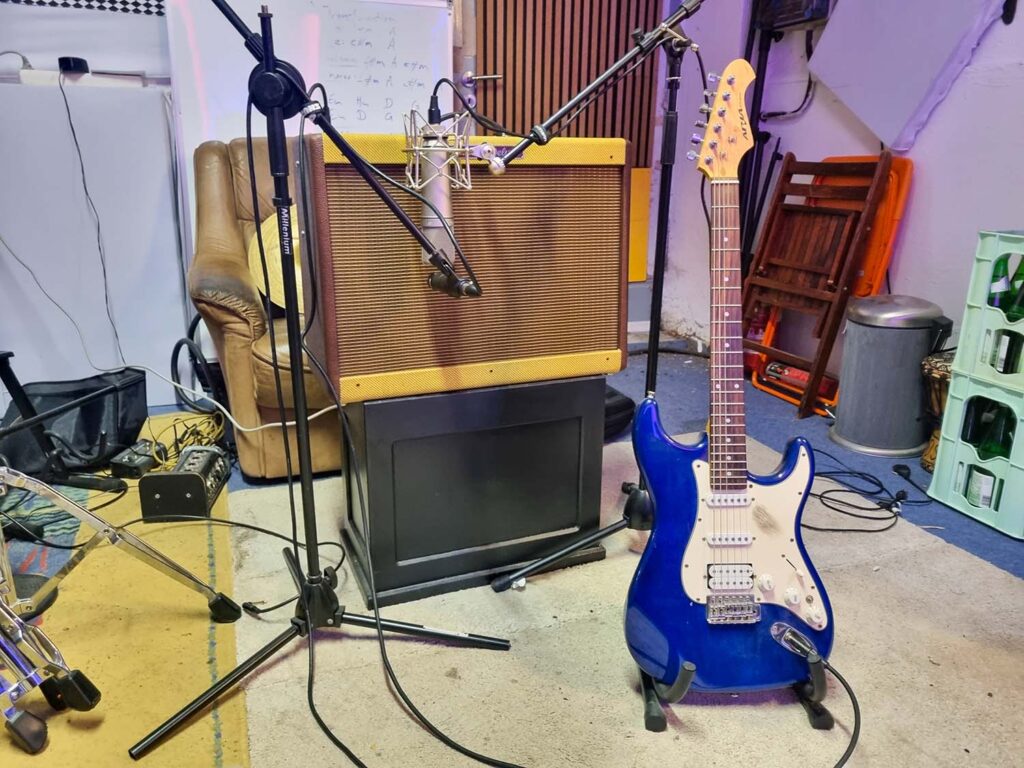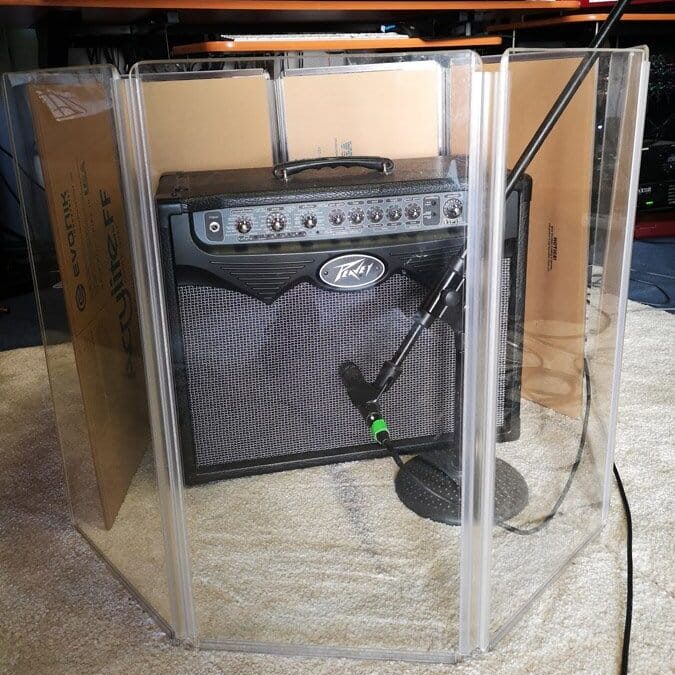Years ago, if you wanted to record an electric guitar, you needed a guitar amp and a microphone. Today, thanks to digital audio processing, there are a few more options that are much cheaper to implement, even for beginners.
Thanks to modern audio interfaces, you no longer need a guitar amp or a microphone - you can plug your electric guitar directly into your interface and simulate an amp in your DAW.
In this article I will explain the 3 most common ways to record electric guitars today, whether at home, in a home studio, or in a professional recording studio:
- Connecting an electric guitar to an amplifier and recording with a microphone (classic method)
- Connecting an electric guitar directly to an audio interface and simulating an amp in the DAW (low budget)
- Recording electric guitar via a multi-FX pedal
You can achieve very good, professional results with all 3 methods. But in my opinion (and in the opinion of many other sound engineers), a real amp still produces a better sound than all the simulations. There are 2 main reasons for this.
First, real tubes in an amp create a distortion that is very difficult to reproduce digitally. The tubes give the sound a lot of overtones and a rich sound that is quite unique. This is why the best bands in the world like Metallica, AC/DC or Green Day still record with real amps, especially in rock, heavy and metal (i.e. where the guitar needs to sound very distorted). For undistorted music, the differences between real and digital amps are less obvious.
The second aspect is that with an amplifier + microphone you are picking up analog sound waves - that is, air moving in front of the microphone. This is exactly what happens when we listen to music. Therefore, it sounds more natural to our ears when we record a real amp with a microphone because the physics of the process is the same as in our ears.
This is not to say that one method is absolutely better than the other - no, each method has its strengths and weaknesses and is intended for different environments and situations. In the following, I will explain each method in detail, showing its advantages and disadvantages, so that everyone can find the recording process that suits them best.
Recording method 1: Guitar amp + microphone
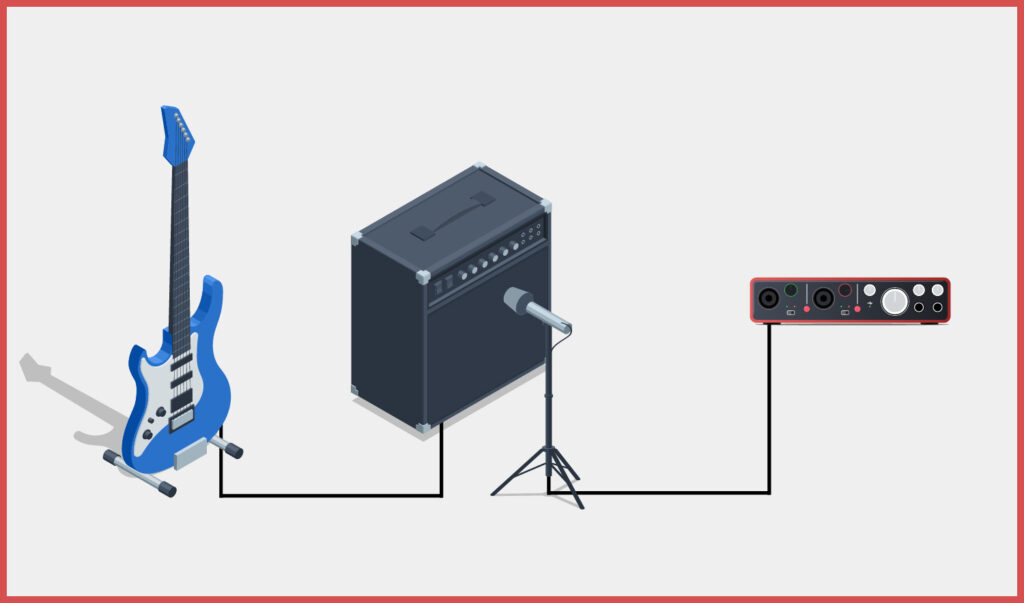
This method involves placing a microphone (usually a dynamic microphone) in front of the guitar amp to pick up the direct sound of the amp.
WHAT YOU'LL NEED
- Electric guitar
- Guitar amplifier (combo, or amp + cab)
- Microphone
- Digital recording capability
ADVANTAGES
- Best possible sound quality
- Easy sound design with a variety of microphone positions
DISADVANTAGES
- The material is expensive to buy (amplifier + microphone)
- The method is noisy, so it may not be suitable for everyone at home.
- Little flexibility: once the guitar is recorded, the amp sound cannot be changed afterwards
You can also use two mics and then combine them to get different timbres. I always use two mics, a dynamic and a condenser (Shure SM57 + Neumann U87Ai).
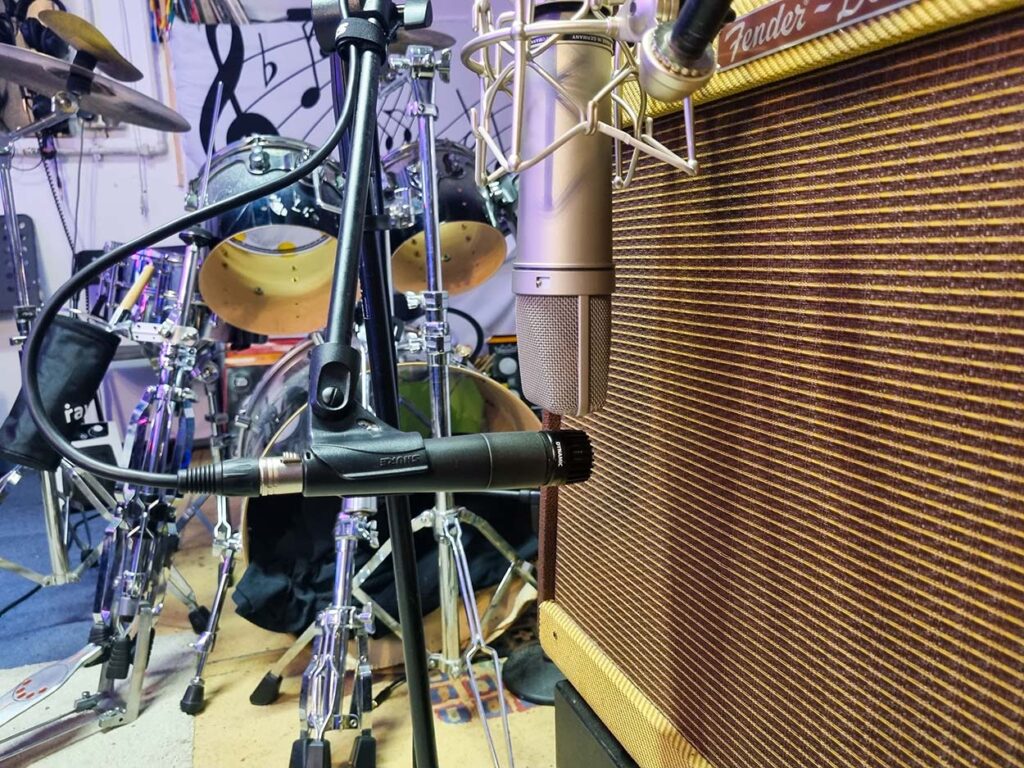
The condenser mic picks up more bass and gives the electric guitar a slightly darker and fuller sound, while the SM57 ensures that the guitar comes through the mix well in the mids.
The capsule of the microphone should be directly in front of the loudspeaker, pointing a little outside the centre. If the microphone points directly into the centre of the speaker, the mid-high frequencies sound a little too harsh and unpleasant.
An old trick to see the guitar amp speaker through the grille is to use a flashlight (the one from your cell phone will do). If you hold it very close to the grille, you can see the speaker well enough to place the exact microphone (see here, first photo).
The closer the microphone is to the speaker, the more bass the sound will have due to the proximity effect. This is neither good nor bad - depending on the sound you want, you can use this property to your advantage.
If you do not have an acoustically optimized room, be sure to use dynamic microphones placed very close to the speaker to pick up as little of the room as possible. The amplifier is usually so loud that the reflections are not heard at all.
Important: The sound of the amp plays a very important role here, as it cannot be changed after recording. Of course, you can add EQs or other effects, but the basic sound remains the same. You can't record distorted and then switch to clean when mixing.
Therefore, you should spend a lot of time adjusting the sound of the amplifier before recording. It is worth making some test recordings with different sounds to compare them later and choose the best sound.
What is the best microphone for recording electric guitars?
The standard electric guitar microphone par excellence is the Shure SM57, which is used in 80% of cases. It has a sound that is very suitable for electric guitars over guitar amps, whether clean or distorted. And the best thing is that this microphone is very cheap, because it costs only a little more than €100.
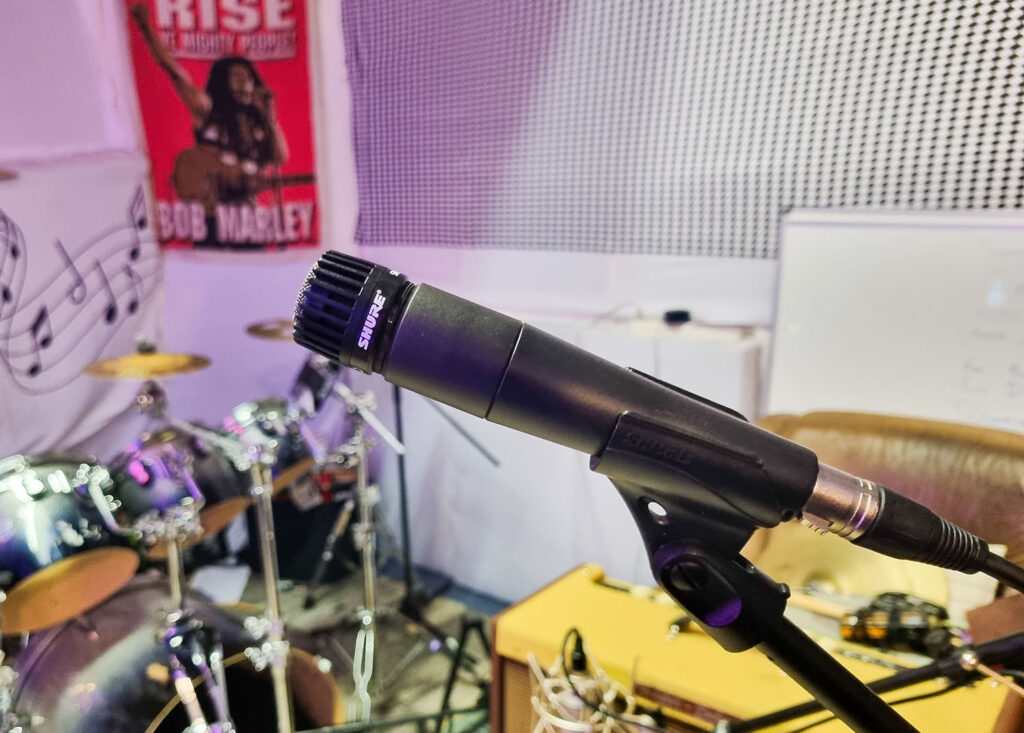
Other popular dynamic mics for recording electric guitars with guitar amps are the Sennheiser MD-421 and the Sennheiser E906. Both microphones deliver a slightly fuller bass than the Shure SM57.
If you want to use a condenser microphone in addition (or instead), you are quite free in your choice here, as all condenser microphones have a very wide frequency response. You can use microphones like the Rode NT1A, the Neumann TLM series or the AKG C series, which all sound very good and natural. I myself use the Neumann U87Ai or the Rode NT1A.
Ribbon microphones are also popular for recording guitar amps because they provide a warmer sound with more harmonics than other types of microphones. They do not require phantom power and are quieter than condenser or dynamic microphones.
However, these microphones often have an "eight" polar pattern. This means that they pick up the area in front of and behind the microphone. If your room is not acoustically optimized, a ribbon microphone will sound bad because it picks up too many reflections. In this case, dynamic microphones are preferable.
Popular bench microphones for this purpose include the beyerdynamic M160, the Royer Labs R-121 and the t.bone RB 100.
As mentioned earlier, it is best to use two different types of microphones at the same time, so that you have many possible combinations and corresponding sound colors. For example, if you use a dynamic and a ribbon mic, you can decide later in the mix whether you want the electric guitar to sound warmer (more volume in the ribbon channel, less in the dynamic channel) or more natural (more volume in the dynamic channel, less in the ribbon channel).
Recording method 2: Connecting the guitar to the interface
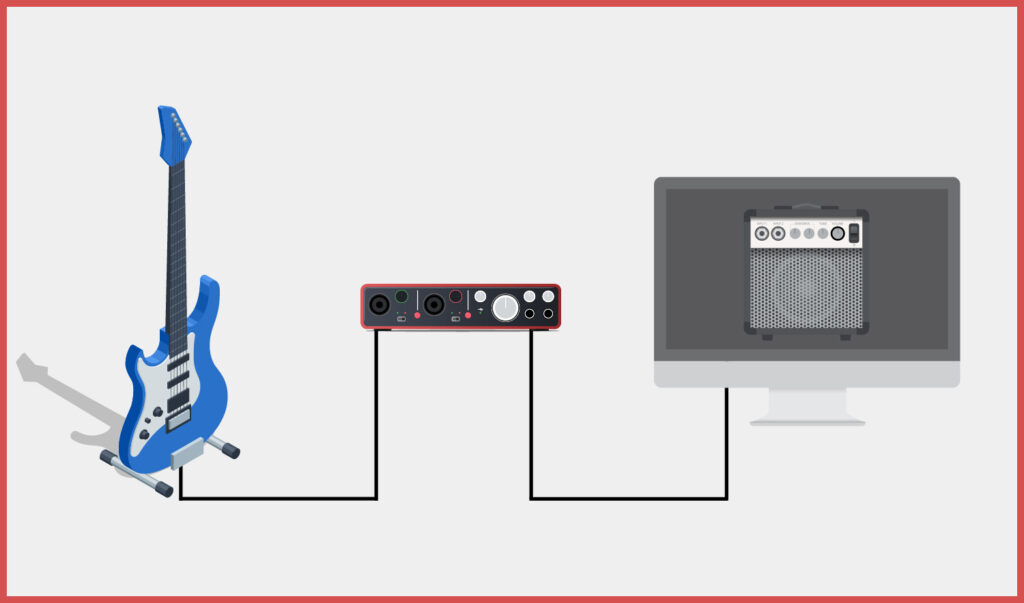
If you have an audio interface and a DAW, you can easily record your electric guitar by connecting it directly to your interface and using an amp simulation in your DAW.
WHAT YOU'LL NEED
- Electric guitar
- Audio interface
- DAW
ADVANTAGES
- Inexpensive because little equipment is required
- High flexibility - you can completely change the sound of the amp after the recording, or even choose a different amp
- Quiet - you can even record using headphones only to avoid disturbing the neighbors
DISADVANTAGES
- With highly distorted music, the amp simulations sound audibly worse than the real amps
The benefits are many: more flexibility in choosing sounds when mixing, the ability to record with headphones only, and most importantly, the cost - you don't have to spend $1000 on an amp + $100 on a microphone.
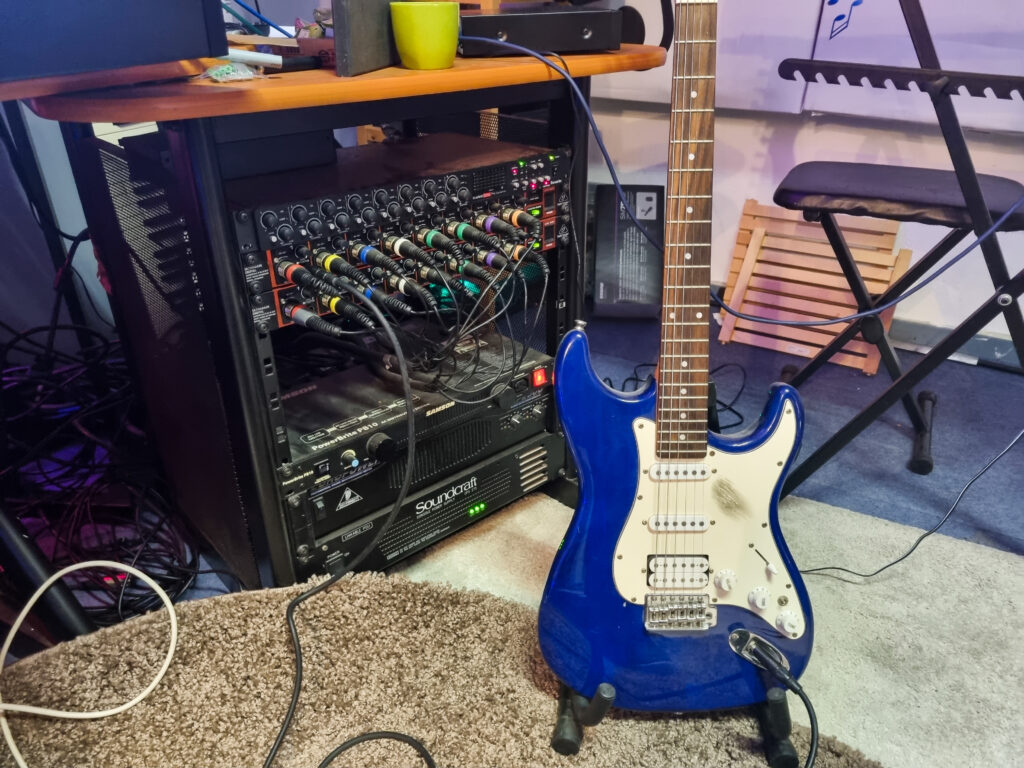
The only drawback is the slightly poorer sound compared to a real amp. In clean recordings the difference is hardly noticeable, especially when other instruments are mixed in. But in genres like rock or metal, the electric guitar with simulation sounds a bit "cheap" and "lifeless", especially in guitar solos.
Using a DI box is not mandatory - all modern interfaces can handle instrument level inputs - but it is recommended. There are very good DI boxes that can improve the sound in such situations. So if you want to record permanently without an amplifier and microphone, a good DI box is worth considering.
Personally, I use the Summit Audio TD-100, a relatively unknown tube DI box that delivers a great sound. When I record with a guitar amp and mic, I also use this DI box from time to time for more shaping options later. Highly recommended!
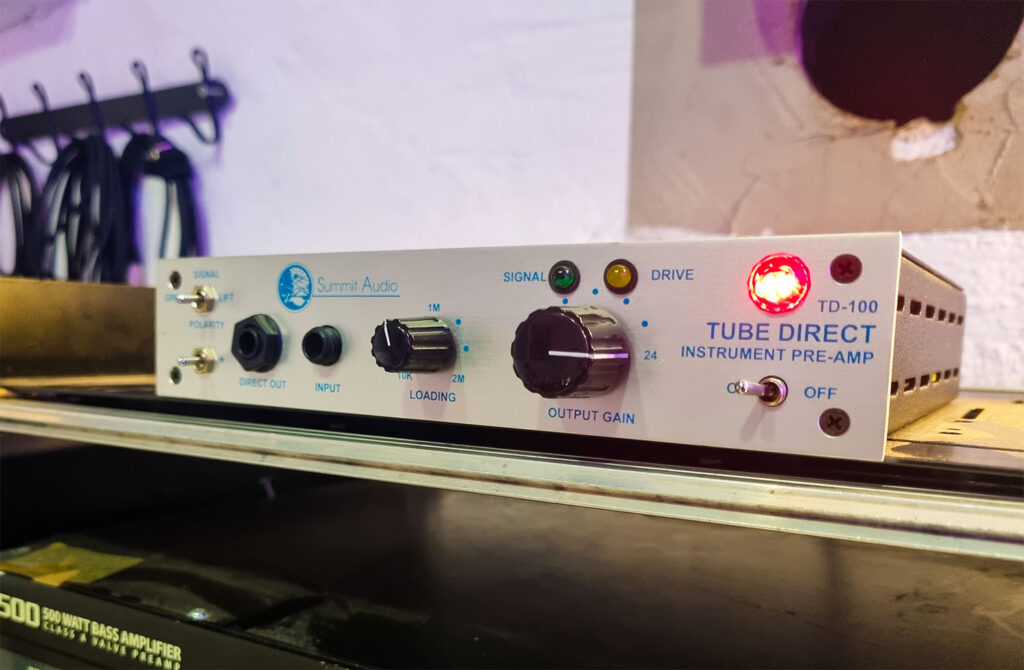
There are now so many amp simulation plugins that you could write a whole article about them. Also, most DAWs now come with stock amp simulation plugins, so strictly speaking, you don't need an additional VST plugin. However, if you're serious, there are some premium options that cost a bit of money but are highly recommended. Here are my favorites:
- My absolute favorite: Native Instruments Guitar Rig
- IK Multimedia AmpliTube 5
- Line 6 Helix Native
Keep reading: Recording bass guitar: A step-by-step guide
Recording method 3: Using a multi-FX pedal
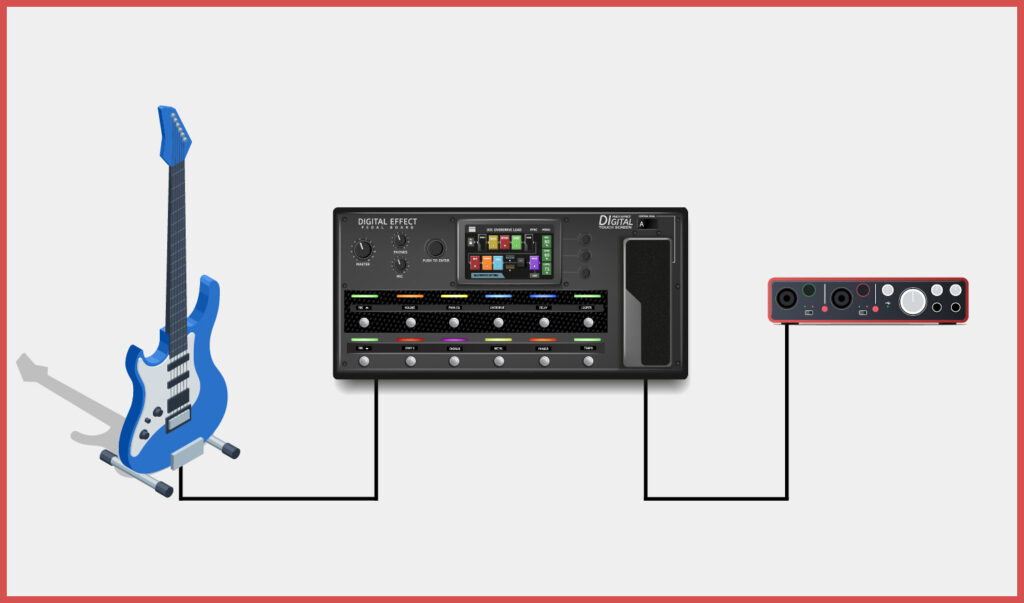
Many guitarists today, especially young ones, no longer see the need to buy a guitar amp and, for practical reasons, turn to multi-FX pedals that offer extensive amp simulations. Devices such as the Line6 Helix Guitar Processor, the Neural DSP Quad Cortex or the Boss GX-100 are also great for recording electric guitars, and usually have a mic-level XLR output for this purpose.
WHAT YOU'LL NEED
- Electric guitar
- Multi-FX pedal
ADVANTAGES
- Useful if you already have a multi-FX pedal
- Great flexibility
- You can use the exact same sounds you use in the studio live
- Quiet - you can even record using headphones only to avoid disturbing the neighbors
DISADVANTAGES
- With highly distorted music, the amp simulations sound audibly worse than the real amps
If you already have one of these pedals, you can start right away and use the sounds that are already pre-programmed. The sound of such pedals is usually a bit better than that of the (cheap) plugins, and it really comes very close to a real amp.
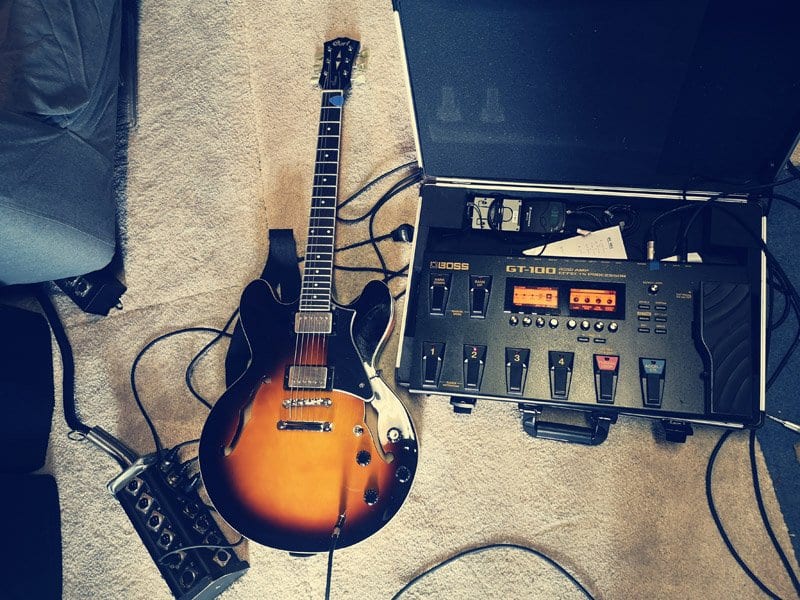
I had a couple of guitarists in my studio that had one of these and I was really amazed at how good they sounded. With high quality units like the Neural DSP Quad Cortex, it's really hard to tell the difference from a real amp. But it costs more than some amps!
You can either connect the pedal's main output to your interface with an XLR cable, or connect the pedal directly to your PC via USB - these pedals also work as audio interfaces because they have AD converters.
So this method is very practical and simple and requires very little equipment - but these multi-FX pedals are very expensive to buy. If you need them for gigs they are worth it, but for pure studio recording I would rather invest 1500€ in a real amp + a Shure SM57. Especially if I need a lot of distortion.
Conclusion
Depending on what you already have and your monitoring situation (can you listen loudly in the studio? At night?), one or the other method may be better. If you already have a good multi-FX pedal for live gigs, I would start with that. Or if you already have a good amp, the cheapest way is to just buy a Shure SM57 and record with it.
If you have the problem of disturbing your neighbors, you can buy an isolation box for your amp so that you can still record at high volume without disturbing anyone. The Isolation Box from Grossman Audio or the Clearsonic Amp Shield are great for this.
Here are some more detailed instructions for home studio recording:





